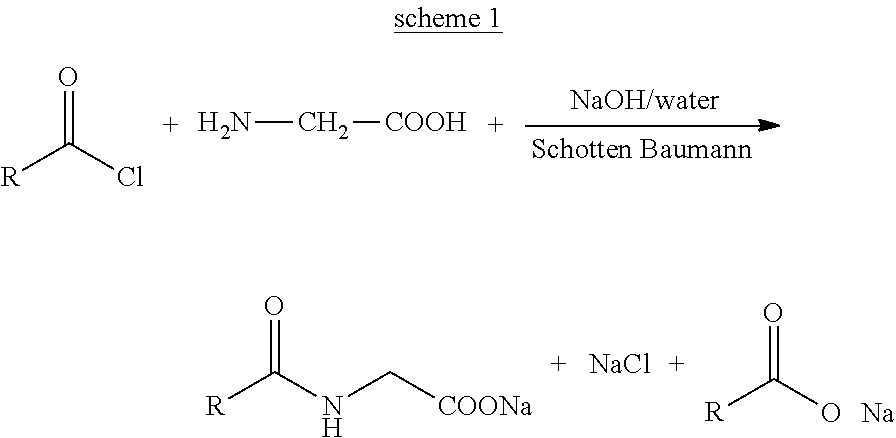Method to produce N-acyl amino acid surfactants using N-acyl amino acid surfactants or the corresponding anhydrides as catalysts
a technology of acyl amino acid surfactants and catalysts, which is applied in the preparation of organic compounds, carboxylic compounds, sulfonic acid preparations, etc., can solve the problems of acid chloride generally not being possible, the product of the catalyst complex being cleaned from the catalyst complex, and the problem of difficult to overcome fatty acid chloride (product) of the catalyst complex, etc., to achieve high throughput
- Summary
- Abstract
- Description
- Claims
- Application Information
AI Technical Summary
Benefits of technology
Problems solved by technology
Method used
Image
Examples
example 1
Preparation of Sodium Lauroyl Glycinate
[0063]It comprises of three steps a) Preparation of Catalyst I: N-lauroyl glycenic lauric anhydride (Formula IV, RCO=lauroyl, R═C11), b) Preparation of lauroyl chloride using Catalyst I and c) Preparation of sodium lauroyl glycinate: Schotten-Baumann reaction of lauroyl chloride with glycine in the presence of a base.
Preparation of Catalyst I: N-Lauroyl Glycenic Lauric Anhydride (Formula IV, RCO=Lauroyl, R═C11)
[0064]To a stirred mass of lauroyl chloride (6.0 g, 0.027 gmol) in dichoromethane (25 mL) under nitrogen blanket at 25° C., freshly oven dried sodium lauroyl glycinate (7.50 g, 0.027 gmol) was slowly added and the reaction mass was stirred for 12 hrs. The reaction mass was filtered and the solvent was removed under vacuum using a rotary evaporator to yield a white solid residue (9.4 g). It has a melting range of 125 to 130° C.
[0065]IR: 1643 cm−1 of CO of amide, 3294 cm−1 NH of amide, 1750 and 1817 cm−1 CO of anhydride, 2849, 2917, 2954 cm...
example 2
Preparation of Sodium N-Lauroyl, N-Methyl Taurate
[0070]It comprises of three steps a) Preparation of Catalyst II: N-lauroyl, N-methyl taurinic lauric mix anhydride (Formula VI, RCO=lauroyl, R═C12), b) Preparation of lauroyl chloride using Catalyst II and c) Preparation of sodium N-lauroyl, N-methyl taurate: Schotten-Baumann reaction of lauroyl chloride with sodium N-methyl taurate in the presence of a base.
Preparation of Catalyst II: N-Lauroyl, N-Methyl Taurinic Lauric Mix Anhydride (Formula VI, RCO=Lauroyl, R═C11):
[0071]To a stirred mass of lauroyl chloride (6.0 g, 0.027 gmol) in dichoromethane (25 mL) under nitrogen blanket at 25° C., freshly oven dried sodium N-lauroyl, N-methyl taurate (9.28 g, 0.027 gmol) was slowly added and the reaction mass was stirred for 12 hrs. The reaction mass was filtered and the solvent was removed under vacuum using a rotary evaporator to yield a white solid residue (14 g).
[0072]IR: 1636 cm−1 of CO of amide, 1723 and 1801 cm−1 CO of anhydride, 2850, ...
example 3
Preparation of Sodium Cocoyl Glycinate
[0077]It comprises of three steps a) Preparation of Catalyst I: N-cocoyl glycenic cocoyic anhydride (Formula IV, RCO=cocoyl, R═C6 to C18) b) Preparation of cocoyl chloride using Catalyst I and c) Preparation of sodium cocoyl glycinate: Schotten-Baumann reaction of cocoyl chloride with glycine in the presence of a base.
[0078]Coco fatty acid that was used to make the catalyst I (N-cocoyl glycenic cocoyic anhydride (Formula IV, RCO=cocoyl, R═C6 to C18), as well as to make cocoyl chloride had the following composition:
C8 (Caprylic acid)—5.38%
C10 (Capric acid)—5.78%
C12 (Lauric acid)—61.37%
C14 (Myristic acid—20.77%
C16 (Palmitic acid)—4.7% and
C18 (Stearic acid)—2.0%
Preparation of Catalyst I: N-Cocoyl Glycenic Cocoic Anhydride (Formula IV, RCO=Cocoyl, C8 to C18):
[0079]To a stirred mass of cocoyl chloride (10 g, 0.045 gmol) in dichloromethane (50 mL) under nitrogen blanket at 25° C., freshly oven dried sodium cocoyl glycinate (12.5 g, 0.045 gmol) was slo...
PUM
| Property | Measurement | Unit |
|---|---|---|
| mass | aaaaa | aaaaa |
| mass | aaaaa | aaaaa |
| temperature | aaaaa | aaaaa |
Abstract
Description
Claims
Application Information
 Login to View More
Login to View More - R&D
- Intellectual Property
- Life Sciences
- Materials
- Tech Scout
- Unparalleled Data Quality
- Higher Quality Content
- 60% Fewer Hallucinations
Browse by: Latest US Patents, China's latest patents, Technical Efficacy Thesaurus, Application Domain, Technology Topic, Popular Technical Reports.
© 2025 PatSnap. All rights reserved.Legal|Privacy policy|Modern Slavery Act Transparency Statement|Sitemap|About US| Contact US: help@patsnap.com



